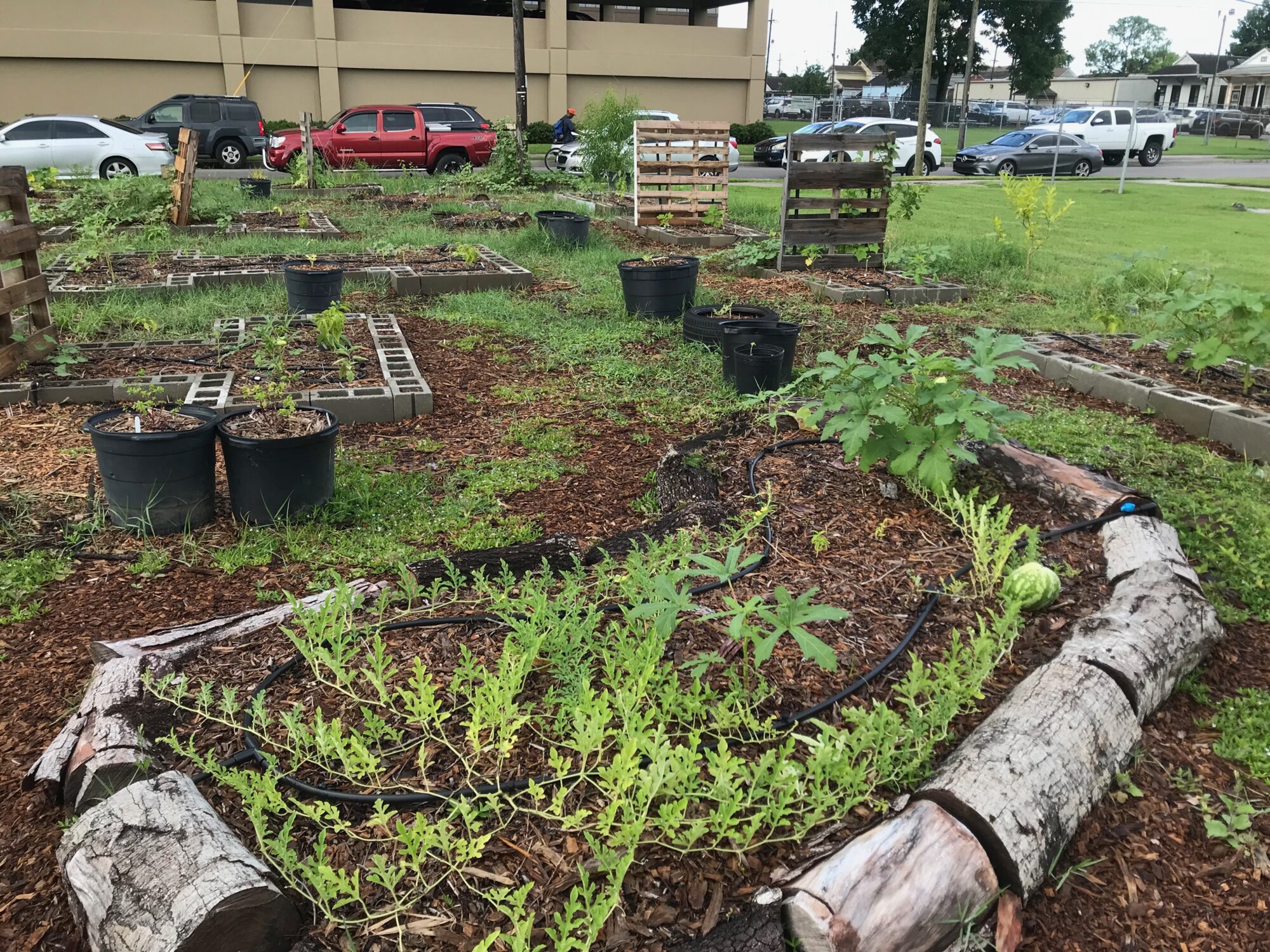Changemaker Catalyst Award recipient Annie Takacs, 4th-year Ecology and Evolutionary Biology major, spent her summer working with a fellow recipient developing systems for the recently developed community garden in partnership with the Salvation Army in the Freret neighborhood of New Orleans. With the support of the S.A. kitchen staff, Director of Social Services, residents, and neighbors, they continue to work toward the goal of establishing this resource for food as well as education and opportunity for food autonomy.
This summer, a classmate and I had the responsibility of stewardship for the Salvation Army Center of Hope Community Garden. The initial construction took place in Spring 2022, with students from Dr. Cheruiyot’s Urban Agroecology and Sustainability in New Orleans course, as well as members of the community. The main goal is to establish a sustainable and productive greenspace that fits the needs of various Salvation Army programs, particularly the kitchen, while also contributing positively to the surrounding community. There have been various challenges, but those have made the accomplishments even more rewarding.
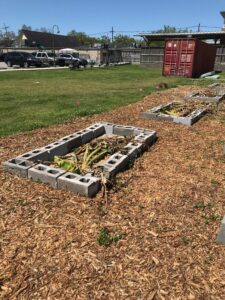
Progress on construction of garden beds in March 2022. Burlap sacks were first put down to separate growing soil from contaminated urban soil. Next, cinder blocks were arranged into ideal shapes for working within beds, and leveled to ensure stability when stacked higher in the future. Banana tree trimmings, recycled from the Food Forest community garden were put in the beds as a natural source of potassium, before beds were filled with a mixture of store bought soil and decomposing donated mulch.
One major test has been communication and goal alignment to ensure the needs of the major stakeholders were met. With our class troubleshooting the situation during the Spring semester, we determined with the Salvation Army kitchen staff, chefs David and Carla, along with the Director of Social Services, Chat, to construct and plant a garden that would be situated as a resource to both the kitchen staff, the residents, and the Freret neighborhood. Without funding for fresh produce, and inconsistent donations of processed foods, not only could this garden help meet the physical needs of the residents, but also allow the chefs to manifest their ideas of farm to table cuisine, exposing residents to a wider range of cultures and flavors and imparting a deeper appreciation for food and where it comes from. We not only hope for the space to be productive, but also an inviting, peaceful, and educational place for all looking to get involved or learn more about urban agriculture.
There have been numerous logistic issues surrounding residential involvement in the project. Engagement is key in encouraging food security and autonomy within the community. Working with Chat, and adapting our vision to incorporate her input, we developed ideas for a Garden Club to include residents in the building and maintenance of the garden.
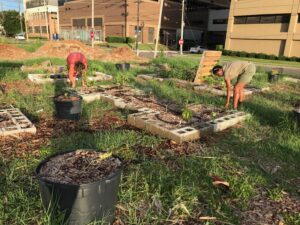
The mounds of mulch in the background have been donated by local tree removal services, and are waiting to be spread out to suppress weeds and help retain moisture among other benefits.
Two of the residents, Sarah and Marie, who have regularly attended the biweekly Garden Club meetings have been helpful and informative voices in the garden. They brought coffee grounds from the local Starbucks and instructed us on proper application for use as fertilizer. Seeing the increased growth due to our combined actions was exciting, and knowing this success was due to coordination with the local community made it even more so. With these residents we’ve discussed our plans for enacting a composting system with the Salvation Army kitchen and surrounding neighborhood, as well as potential partnerships with horse stables to begin utilizing composted manure as fertilizer.
Acquiring materials and manual assistance affordably and sustainably is a major hurdle in community gardens, requiring community outreach. By connecting with organizations and community gardens and individuals across the city, we’ve learned that there are solutions to many obstacles that don’t require excessive energetic and economic expenditure. This sourcing part of our work can consistently be improved upon and will hopefully grow and flourish along with the garden.
Poor crop yields due to the location of the garden is another challenge. While decreased yields are typical for a garden’s first season, it’s been exacerbated by intense light exposure with little cloud cover or rain during the drought, plus the encompassing buildings and roads. This has been remedied in part through the use of palettes placed upright to serve both as a trellis and as a sun shield. This has provided a vertical growing space for vining plants like Cucurbits, which can greatly increase their production. Another solution has been the construction and implementation of a drip irrigation system that extends to all the plants in the garden beds.
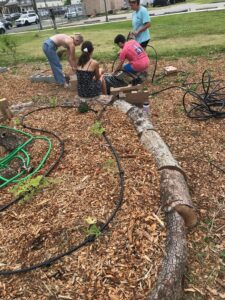
The bean shaped “watermelon bed” in the foreground was an experiment in using repurposed logs that had been donated by tree removal services. We believe that this very sustainable mode of garden bed construction could help to retain more moisture and support healthier ecological relationships than the cinder block beds.
Moving forward in the upcoming semester we plan to incorporate several service learning courses into weekly garden club events as we transition into winter crops. Other future plans include expansion of bed construction within the garden lot to maximize the crop yield and ecological activity within the space. We hope to continue to find new ways of fertilization, such as partnering with local horse stables and other organizations that we can be mutualistic with. We’ve also used part of an NTC grant received during the semester to purchase large compost bins, which will soon be implemented, allowing food scraps from the Salvation Army kitchen and surrounding community to become fertile soil for the garden.
The modest harvests of herbs, okra, hot and bell peppers that have gone to community members and the Salvation Army kitchen this summer have been gratifying. Even more significant has been the relationships we’ve built with residents and neighbors. An invested neighbor has brought us several of his own plant starts, and dedicated much of his time and knowledge to helping us with maintenance during the summer. The sentiment coming from many residents and community members is that people are excited and grateful for the opportunity, and seeing people dedicated to the garden’s success is motivational, driving people to get involved.
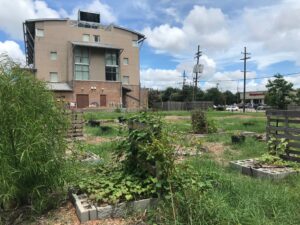
This garden project is a changemaking experience in that it’s part of a larger network of projects that aim to build alternate resources to the mainstream agricultural and food industries. Worsened greatly by the pandemic, living prices in New Orleans are grossly high in comparison to average wages. Working within communities to turn unused spaces into productive gardens is a feasible and ecologically viable solution to some major hurdles faced by the bulk of the population.
A long term aim for the project is that while still providing fresh produce to the kitchen, it will eventually be managed more by members of the community than by the Salvation Army administration or Tulane affiliates. Gaining the knowledge and skills to care for this greenspace as well as to meet needs by creating connections in the community has been very empowering, and is an opportunity that we want everyone to have access to. We hope that just as the plants produce, re-seed and propagate, so too will this resource continue to grow into the community.
